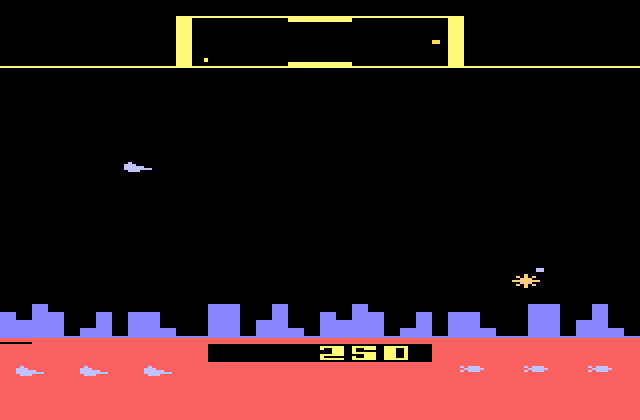Its also a multi-role game approaching metaphysical properties. During the final chapter when the central protagonist is trapped, s/he still has the ability to manipulate items on the other side of the room. This is not the only example.
Wittgenstein discusses common features in games in terms I would previously refer to as style , with genre or form. Family resemblances occur between Defender and Falcon Patrol, so closely that one may be a template for the other, Falcon Patrol a more technologically advanced and visually appealing version with sound. Gameplay is essentially the same. Defender is quite far removed from GoldenEye, though it has its small sub-screen map running alongside the main screen. The scrolling screen of Defender/Falcon Patrol is legitimised in modern racing games' lap system.

Defender (Atari 1982 above), Falcon Patrol (Commodore 64, 1983, below)

SissyFight and Fighting Fantasy are both games with themes of combat and largely utilise text and bare-motion graphics. Frogger and Space Invaders are cousins because of similar character movement, and deluxe and Gen One versions will likely be forever similar in this characteristic. It seems fair to extend ‘word’ or ‘concept’ to ‘genre’ in a number of places, when talking art, be it video game, comics, music, cinema. Words and concepts will always be the strongest source for reference. Manic Miner and Donkey Kong are both games were low income workers must climb 3-5 levels of platforms, against great odds and enemies, to complete an objective. However, both keep their gorillas and scaffolding at different points of focus, while barrels represent a minimal tool in one and a direct threat in another. Wittgenstein’s concept is flawed only when the physical intrusion of gamer’s cramp can be felt some time after the game, a theory stretched when it meets some of the more tabloid-y stories about the wii.
(Word count: 401)
References
McCloud, S. (2000) Understanding Comics: The Invisible Art, HarperPerennial
McCloud, S. (2000) Reinventing Comics: How Imagination and Technology Are Revolutionizing an Art Form, HarperPerennial
Poole, Steven (2000) Trigger Happy: Videogames and the Entertainment Revolution. New York: Arcade.
Bobin, James (director/producer) (2001). Thumb Candy [television broadcast]. 49 min. UK: Talkback/Channel 4. Retrieved 4 March 2007 from http://video.google.com/videoplay?docid=4246941477827658335
Wittgenstein at Wikipedia. Retrieved online on 10th March at http://en.wikipedia.org/wiki/Ludwig_Wittgenstein
The Video Game Critic's Atari 2600 Reviews D-E Retrieved online on March 11th at www.videogamecritic.net/images/2600/defender.png
The Greatest C64 Games of All Times Falcon Patrol screenshot, retrieved online on March 11th at c64s.com/games/gif/1240.gif
